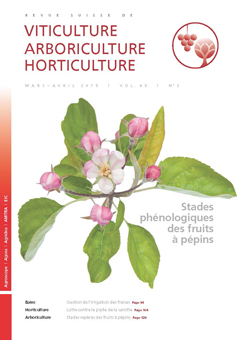
Issue 2 - March - April 2013
Abstract in open access
In 2010, 2011 and 2012, the irrigation of strawberry based on Watermark® probes and managed by WEM (Watermark® Electronic Module) was tested under tunnel at Agroscope Conthey. It was compared with the traditional irrigation system using tensiometers. The WEM controlled treatment allowed a reduction of irrigation water of around 50 % and a slight increase of the yield, without any significant differences in fruits quality parameters, such as fruit size, firmness and sugar content.
Keywords: strawberry, irrigation, soil moisture measurement, water saving
E-Mail: andre.ançay@agroscope.admin.ch
Adress: Agroscope, 1964 Conthey
Abstract in open access
The project aimed to analyse the influence of the regulated deficit irrigation for apple trees cv. Gala on the yield and the commercial, sensory and nutritional quality of the fruits, as well as the water use. Four irrigation treatments were tested in 2010 and 2011 based on the fruit development (first period P1 from full bloom to end of fruit cell division, second period P2 during fruit cell growth, third period P3 during fruit cell growth and maturation, about four weeks before harvest): T1: non-irrigated, T2: comfort irrigation from P1 to P3, T3: no irrigation during P2, T4: regulated deficit irrigation during P2 with a threshold at –1.2 MPa for the midday stem water potential (MSWP). The irrigation treatments had no impact on the fruit yield and the increase of the trunk diameter. However, compared to comfort irrigation (T2), the absence of irrigation (T1, T3) increased the MSWP over –1,2 MPa during P2 and influenced negatively the commercial quality of the fruits (fruit size and coloration). In contrast, for these two irrigation treatments, the increase in water stress was related with a slight increase in sugar content and firmness of the apples, as well as in their contents in vitamin C and polyphenols and in their antioxidant activity. The regulated deficit irrigation (RDI, threshold for irrigation at –1.2 MPa for the MSWP from 60 days after full bloom till four weeks before harvest) allowed to reduce water use of 47 % without loss in fruit yield and commercial, sensory and nutritional quality of the fruits.
Keywords: apple, midday stem water potential, RDI, soil matrix potential, sub-drip-irrigation
E-Mail: philippe.monney@agroscope.admin.ch
Adress: Agroscope, 1964 Conthey
Abstract in open access
The carrot psyllid (Trioza apicalis) is a serious pest in several regions of carrot production in Switzerland. The insect overwinters on conifers and starts migration to carrot fields in mid- to late May. From seed germination to the 4–5 leaf stage, insect feeding on plantlets causes leaf curling and may completely block the development of roots. Currently, the control of the pest relies on insecticide sprayings on young plantlets, but this leads to a major waste of products on the bare soil as a consequence of the low foliage cover at the time of application. Thus, the use of coated seeds could be an interesting alternative to spraying. A field experiment was conducted to compare the efficiency of seeds coated with either clothianidin (Poncho), clothianidin + β-cyfluthrin (Poncho Beta) or clothianidin + imidacloprid (Sepresto) to a conventional spray application of λ-cyhalothrin (Karate) and an untreated control. Our results show that plantlets of coated seeds were significantly less damaged than those of the insecticide reference and the untreated control. However, no differences were found among the three types of seed coating. In autumn, a significant higher number of roots were harvested from all four insecticides treatments than from the untreated control. In laboratory analyses, no traces of insecticide residues could be detected in root samples. We conclude that seed coating could be an interesting and efficient measure for an IPM-strategy against the carrot psyllid.
Keywords: Trioza apicalis, Daucus carota, seed treatment, plant protection
E-Mail: serge.fischer@agroscope.admin.ch
Adress: Agroscope, 1260 Changins/Nyon
Abstract in open access
In 2008 and 2009 two trials were carried out to measure the influence of the suckers and pruning wood management on population densities of S. titanus in the vine canopy. Our results showed that individuals of the first larval instars concentrated on suckers leaves. In 2008 the disbudding of these organs reduced significantly the density of S. titanus in the canopy, but this effect could not be observed in 2009. Thus, this practice accompanied by the removal or chopping of the pruning wood does not allow to reduce significantly populations densities of S. titanus, although reductions between 8 to 52 % were observed locally. Even if these prophylactic measures may induce a density decline of S. titanus in the foliage, they have to be considered as complementary tools to the mandatory control strategy.
Keywords: mandatory control, leafhopper, spatial distribution, Flavescence dorée
E-Mail: mauro.jermini@agroscope.admin.ch
Adress: Agroscope, 6593 Cadenazzo
Abstract in open access
Across export markets, consumers use a range of criteria in their evaluation of wine during the process of purchasing. However, one common purchasing criteria is the notion of the ‘region’ recognised as one of the most important criteria in this process .For French consumers, the concept of region may represent more than just a specific location and is frequently associated with the ‘terroir’. The challenge for European producers is to recognise the characteristics pertinently expressing terroir for consumers, and then the way to communicate them to consumers. The literature is relatively poor about the consumer’s knowledge on terroir. The present study could establish that French consumers consider terroir to be important, but with little consensus on the meaning of this concept. Most of the responses related terroir to geographical origin. Variations in the number of terms provided for explaining terroir correlated with the evaluation of consumer’s level in wine involvement. These results confirm that an appropriate communication strategy using terroir must focus on the wine’s provenance and be adapted to the consumers degree of wine involvement.
Keywords: terroir, consumers, best-worst method, involvement, wine purchasing
E-Mail: f.jourjon@groupe-esa.com
Adress: Ecole supérieure d'agriculture d'Angers ESA, F-49007 Angers Cedex 01

 Download of full issue
Download of full issue
 Download article
Download article